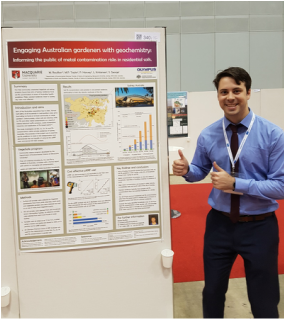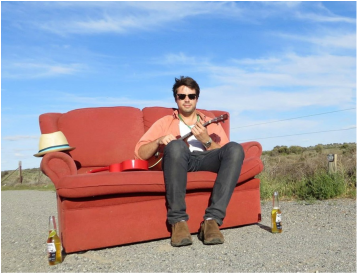A Day in the Life of an X-ray Scientist
Marek Rouillon
|
CURRENT TITLE: PhD Candidate
ORGANISATION: Dept. of Environmental Sciences, Macquarie University AREA OF EXPERTISE: Application of field portable XRF in the assessment of metal-contaminated soils. YEARS OF EXPERIENCE: 3 EDUCATION: Bachelor of Environmental Science (Hons), Macquarie University WEBSITE/TWITTER: Research Website |
 Outcomes of a 3 year long community science program: VegeSafe.
Outcomes of a 3 year long community science program: VegeSafe.
What does your job involve?
My PhD research revolves around the use of portable X-ray Fluorescence (pXRF) technology and how it can be better implemented for use in environmental science investigations. My research is split into three main areas; evaluation, method development and application of pXRF. I also help run our very successful Macquarie University VegeSafe program, where we provide Australian residents access to free soil metal screening. We have assisted over 1,000 families and have screened in excess of 5,000 soil samples as a result of this Australia wide free service.
What’s a typical day like?
Thankfully, my days are often quite varied. The demands of completing a PhD frequently keep me in an office environment however I can often be found out in the field at metal-contaminated sites in and around Sydney. I also spend some time assisting fellow PhD candidates with fieldwork in a range of different disciplines. When I am in the laboratory, I work on matrix calibrations for our pXRF instrumentation and measure the metal content of garden soils from across Australia as part of our VegeSafe community science program.
What do you love about working with X-rays?
I remember when my research supervisor Professor Damian Gore first introduced me to XRF, I was immediately impressed with the techniques ability to quantify elements in pretty much anything. Such an uneducated, wide eyed boy I was. I also love to be able to say I work with X-ray guns.
What’s challenging?
Perhaps the most challenging part of my research is perspective. I often find myself obsessed with small details within my research, however important or trivial they may be, that I need to keep reminding myself to step back and envision the bigger picture of the work. Falling down such rabbit holes in research isn’t necessarily a detriment to the work, it just shows you have that critical attention to detail.
Why is it good to be involved with AXAA?
AXAA was the first conference I attended back in 2014, and really set the benchmark high as my first experience. It provides an excellent opportunity to connect with colleagues and delegates in the same technical field of X-rays, this proves more difficult at larger conferences, and opens doors for early career scientists through excellent networking opportunities.
My PhD research revolves around the use of portable X-ray Fluorescence (pXRF) technology and how it can be better implemented for use in environmental science investigations. My research is split into three main areas; evaluation, method development and application of pXRF. I also help run our very successful Macquarie University VegeSafe program, where we provide Australian residents access to free soil metal screening. We have assisted over 1,000 families and have screened in excess of 5,000 soil samples as a result of this Australia wide free service.
What’s a typical day like?
Thankfully, my days are often quite varied. The demands of completing a PhD frequently keep me in an office environment however I can often be found out in the field at metal-contaminated sites in and around Sydney. I also spend some time assisting fellow PhD candidates with fieldwork in a range of different disciplines. When I am in the laboratory, I work on matrix calibrations for our pXRF instrumentation and measure the metal content of garden soils from across Australia as part of our VegeSafe community science program.
What do you love about working with X-rays?
I remember when my research supervisor Professor Damian Gore first introduced me to XRF, I was immediately impressed with the techniques ability to quantify elements in pretty much anything. Such an uneducated, wide eyed boy I was. I also love to be able to say I work with X-ray guns.
What’s challenging?
Perhaps the most challenging part of my research is perspective. I often find myself obsessed with small details within my research, however important or trivial they may be, that I need to keep reminding myself to step back and envision the bigger picture of the work. Falling down such rabbit holes in research isn’t necessarily a detriment to the work, it just shows you have that critical attention to detail.
Why is it good to be involved with AXAA?
AXAA was the first conference I attended back in 2014, and really set the benchmark high as my first experience. It provides an excellent opportunity to connect with colleagues and delegates in the same technical field of X-rays, this proves more difficult at larger conferences, and opens doors for early career scientists through excellent networking opportunities.

